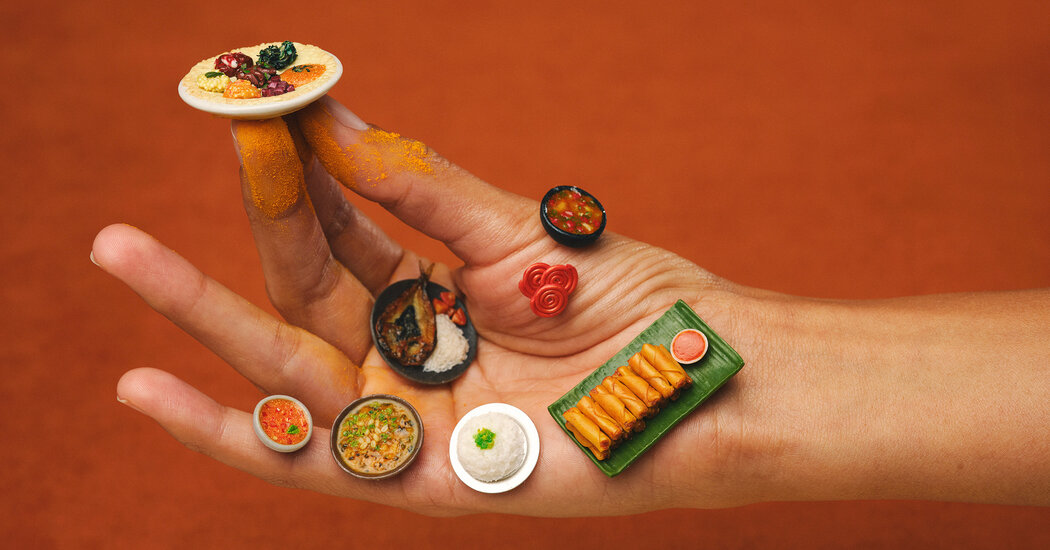Still, the rise of the kamayan dinner shouldn’t be taken as a sign that Americans are relinquishing their hold on cutlery. If anything, part of the appeal of eating with the hands, at least for those who don’t do it regularly, is precisely that it’s a break from the norm, made permissible because the food itself is unfamiliar. The American philosopher Lisa Heldke has called such forays “eating adventures” and questioned her own curiosity in pursuing them, wondering if she was unconsciously following the same impulse that drove “19th- and early 20th-century European painters, anthropologists and explorers who set out in search of ever ‘newer,’ ever more ‘remote’ cultures.” Although she was trying “to learn about other cultures in ways I intended to be respectful,” she writes in “Exotic Appetites: Ruminations of a Food Adventurer” (2003), “I could not deny that I was motivated by a deep desire to have contact with, and to somehow own an experience of, an Exotic Other, as a way of making myself more interesting.” Are diners who wander outside their own culture doomed, then, forever to be tourists?
Herein lies the conundrum for chefs and restaurateurs trying to introduce the food of their heritage to a Western audience: how to do so without either self-exoticizing or whitewashing, playing up or playing down what might be considered the more challenging elements of a cuisine — the crunch of a duck embryo’s bones, say, or the frank scent of fermented fish sauce that remains on the fingers long after the food is gone.
SPOONS OF MAMMOTH bone from around 23,000 to 22,000 years ago have been found in western Russia; chopsticks, known in China as zhu and later kuaizi, may go back as far as 5000 B.C. But historians can only speculate what these early utensils were used for, whether they were all-purpose tools or designated for cooking, rather than for individual dining. Knives were weapons first. In a 1927 survey of antique cutlery collections, the English curator C.T.P. Bailey noted that, even in the Middle Ages, only the nobility had dedicated table knives, while “the ordinary citizen carried at his girdle a knife which served all purposes and could be used equally well for carving his food or cutting his enemy’s throat.” In 17th-century France, Louis XIV banned all pointed knives, perhaps, Bailey muses, “to discourage assassination at mealtimes.” In China around the fourth century B.C., people began to shift from hands to spoons (shaped like daggers) and chopsticks, perhaps because those living in the colder north preferred foods that were boiled and presented in hot broth, as the Chinese American historian Q. Edward Wang suggests in “Chopsticks: A Cultural and Culinary History” (2015).
In Europe, people deployed spoons for soup and knives for cutting and impaling, but otherwise continued to rely on their hands. Forks came late. The “Iliad,” composed in the eighth century B.C., refers to “five-pronged forks” arrayed for the roasting of an animal sacrifice, but these were essentially large stabbing tools. A smaller, five-inch bronze implement with two rippled tines from the sixth or seventh century A.D., excavated in modern Iran, may be evidence that some Persians had adopted them for eating around that time. In the 11th century, an Italian Benedictine monk noted disapprovingly that a Constantinople-born bride of the Doge of Venice had brought with her to the West the decadent habit of dining with a fork. “She did not touch her food with her hands,” the monk wrote, outraged, and pointed to her death from plague as an apparently suitable fate for one of such “excessive delicacy.” To a man of God, this was a dangerous foreign affectation and betrayal of nature. And for centuries the fork remained suspect in Europe, as the effete accessory of aristocrats; as late as the 17th century, Louis XIV, amid the pomp of Versailles, is said to have insisted on grabbing food — off a gold plate — with his fingers.
We know how the story ends. There were practical reasons to submit to utensils. Not for purposes of hygiene, which was little understood at the time; the 12th- and early 13th-century Sephardic physician and philosopher Maimonides, who was born in Andalusia and spent most of his life in northern Africa, advocated washing the hands in medical settings to prevent contagion, but that practice wasn’t standardized until after the advent of germ theory in the 19th century. (If anything, tableware allowed for a different, more magical kind of contagion: The English historian Emanuel Green, in a paper presented to the Somerset Archaeological and Natural History Society in 1886, slyly offers a quote from a man of Malay origin, confronted with a British place setting: “What do I know of this fork? It has been in a hundred or more mouths — perhaps in the mouth of my greatest enemy.”)







